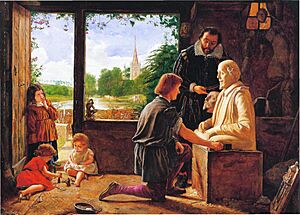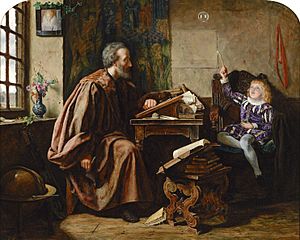Henry Wallis facts for kids
Quick facts for kids
Henry Wallis
|
|
|---|---|
| Born |
Henry Wallis
21 February 1830 |
| Died | 20 December 1916 (aged 86) |
Henry Wallis RWS (born February 21, 1830 – died December 20, 1916) was a British painter, writer, and art collector. He is known for being part of the Pre-Raphaelite art movement.
Contents
Early Life and Training
Henry Wallis was born in London on February 21, 1830. His mother, Mary Anne Thomas, married Andrew Wallis in 1845. Andrew was a successful architect in London, and Henry took his stepfather's last name.
Henry Wallis had a very good art education. He joined the Royal Academy as a student in March 1848. He also studied art in Paris at Charles Gleyre's studio and at the Academie des Beaux Arts between 1849 and 1853.

Famous Paintings
Wallis is most famous for his painting The Death of Chatterton, which he showed at the Royal Academy in 1856. This painting shows Thomas Chatterton, a young poet from the late 1700s. Chatterton sadly took his own life at age seventeen. Many young artists at the time saw him as a Romantic hero.
Wallis's painting style in The Death of Chatterton shows how important the Pre-Raphaelite movement was to him. You can see this in the bright colors and the careful details that have special meanings. He used strong colors that stood out against each other. He also used natural light coming through the window to create a style called chiaroscuro. This means using strong contrasts between light and dark.
The room where Chatterton is shown was very small, just a bit bigger than the painting itself. Wallis had just enough space for himself and his easel when he made the first sketches. The painting is 25 by 37 inches and is kept at the Tate Britain museum. Other versions of this painting are in the Birmingham Museum and Art Gallery and the Yale Center for British Art.
The Death of Chatterton was very popular. Wallis sometimes painted more versions of it when he needed money. He once joked that paintings of dead poets sold better than paintings of dead workers. This was a funny way to talk about his next big painting, The Stonebreaker.
The Stonebreaker (painted in 1857 and shown in 1858) helped Wallis become known as a true Pre-Raphaelite artist. He showed 35 paintings at the Royal Academy in total. Later in his life, he became more interested in painting with watercolors. He became a full member of the Royal Watercolour Society (RWS) in 1878. He showed more than 80 watercolor paintings at the society.
The young man who modeled for The Death of Chatterton was George Meredith, who later became a famous writer. Meredith's first wife, Mary Ellen, later started a relationship with Wallis.
Painting Style
In his early career, especially for The Death of Chatterton, Wallis had a special way of painting. First, he would make an initial sketch and wet it with water. Then, he would use a gray color to block in the shaded areas. After that, he would add the main colors and let them dry. Once the paint was firm, he used a very fine brush to add all the small details he was famous for. To create light in his paintings, he would touch the area with water and then gently rub it with a piece of bread. During these years, his art studio was in Chelsea, a part of London that was known for artists and creative people.
Later Life
Henry Wallis passed away on December 20, 1916, in Croydon. He was almost blind at the time of his death.
Images for kids
See also
 In Spanish: Henry Wallis para niños
In Spanish: Henry Wallis para niños




